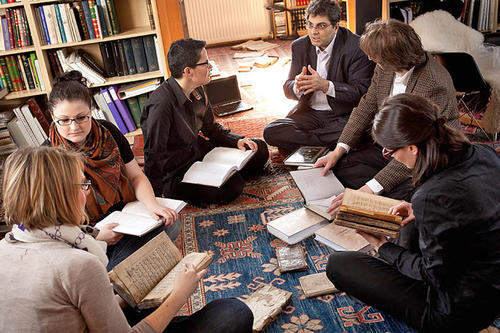Ways of Reading the Bible
Islamic studies scholar Sabine Schmidtke and an international team of researchers study historical translations of scripture into Arabic
Oct 30, 2012
Focusing on ancient texts: Islamic studies scholar Sabine Schmidtke (3rd from left) and a group of researchers from around the world are analyzing early Arabic translations of the Bible.
Image Credit: E. Fessler
This research is both fundamental and necessary, if for no other reason than because of the complicated logistics involved. Important manuscripts from the 8th and 9th centuries are kept in libraries in various locations, including Saint Petersburg, the Sinai region, Cairo, Lebanon, Syria – and Berlin. Only a few sources have been analyzed so far, and even fewer have been subjected to scholarly discussion. “We have to fill this gap,” says Sabine Schmidtke. “After all, these are key texts, and they play an important role not only in theological analyses, but also in intercultural studies.”
The first Arabic translations of the Bible date back to the 8th century. It was a time when a paradigm shift with far-reaching effects was taking place. “With the rise of Islam, we can see that Christians, Jews, and Samaritans stop speaking their original languages relatively quickly,” says Schmidtke, a scholar of Islamic studies. Among the Jews, that meant Hebrew and Aramaic, while Christians spoke Syriac, Greek, and Coptic, and Samaritans spoke several different languages. By the 10th century at the latest, Arabic had largely displaced all of them.
As a result, many believers could no longer read or understand scripture in their original languages. Translators began to translate the Bible into Arabic – with different background ideas, ideologies, and types of understanding. These differences lie at the heart of the research alliance’s project. “We have different traditions of translation that vary widely, not only within the religions, but also within the cultures in their specific geographic extents. This yields a complex picture filled with different interpretations, and one that has not yet been adequately studied.”
The manuscripts doubtless have tremendous scholarly value. After all, the documents offer information on not only how Arab Christians understood scripture, but also how various branches of Islam interpreted the Bible. “Some parts of the Bible were read as announcing Mohammed as a prophet. The background is the self-image of the Koran, which views itself as the final perfect revelation, thereby placing itself in the tradition of the Old and New Testaments. For that reason, this material has always been of interest to Muslims.”
There are also various Bible translations by Jewish scholars, who established a third tradition of translation alongside the Christian and Islamic traditions. There are a number of questions for present-day scholars: How did cultural values affect the translations? What types of terms were used in the Arabic traditions of translation? Where was there dialogue between the cultures, and where were there differences of opinion? “These kinds of questions can’t be answered from a single perspective alone,” Schmidtke says. “It’s only possible through joint interdisciplinary research.”
With that in mind, the researchers involved in the project aim to pool the existing knowledge regarding the various Bible translations in a central location, thereby enabling comparative interpretations. “We want to bring together voices from the Christian, Jewish, and Muslim traditions of Bible scholarship and look at them together with Muslim reception of scripture.”
Further Information
Prof. Dr. Sabine Schmidtke, Freie Universität Berlin, Research Unit Intellectual History of the Islamicate World, Tel.: +49 (0)30 838-52487, Email: sabineschmidtke@gmail.com

